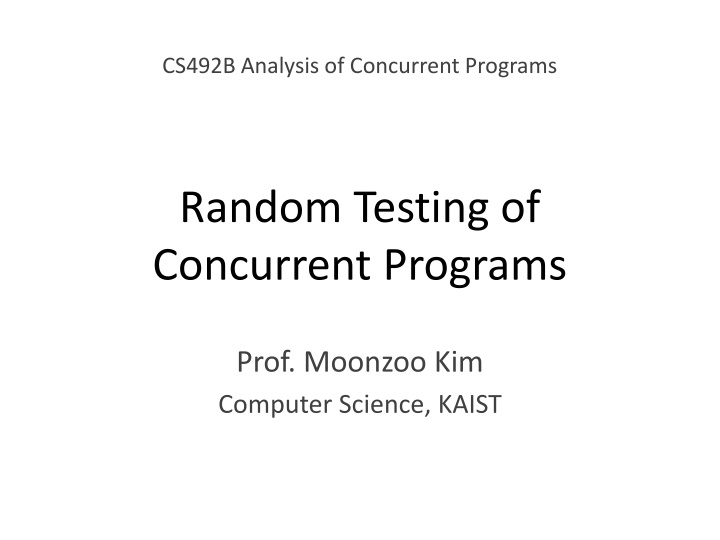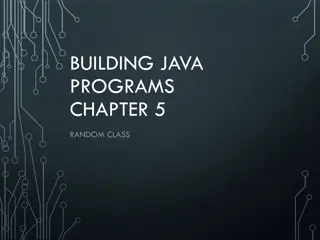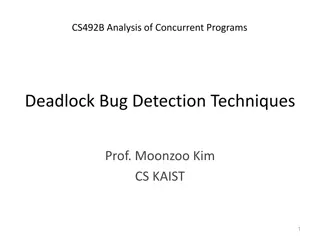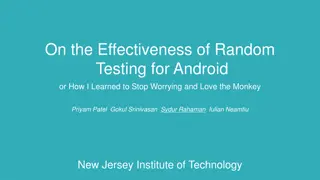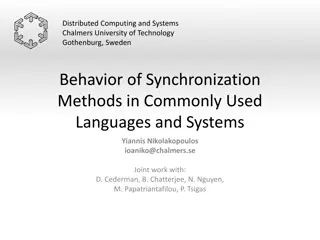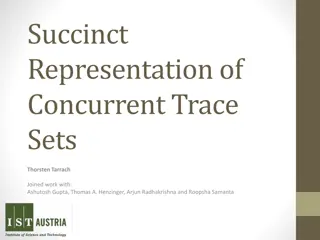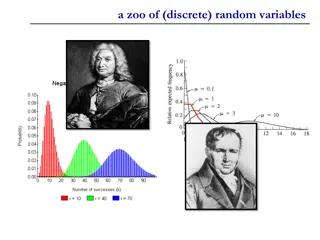Analysis of Concurrent Programs: Random Testing
Testing concurrent programs involves running a target program with different inputs and thread schedules to detect faults without abstraction or false positives. Random testing challenges traditional testing methods but can reveal concurrency bugs that only appear with specific schedules. Stress testing can push programs under heavy workloads to generate unusual thread schedules, but it has limitations in diversity and predictability.
Uploaded on Mar 07, 2025 | 0 Views
Download Presentation

Please find below an Image/Link to download the presentation.
The content on the website is provided AS IS for your information and personal use only. It may not be sold, licensed, or shared on other websites without obtaining consent from the author.If you encounter any issues during the download, it is possible that the publisher has removed the file from their server.
You are allowed to download the files provided on this website for personal or commercial use, subject to the condition that they are used lawfully. All files are the property of their respective owners.
The content on the website is provided AS IS for your information and personal use only. It may not be sold, licensed, or shared on other websites without obtaining consent from the author.
E N D
Presentation Transcript
CS492B Analysis of Concurrent Programs Random Testing of Concurrent Programs Prof. Moonzoo Kim Computer Science, KAIST
Testing of Concurrent Programs A test runs a target program with given input to generate actual executions (test case executions) to detect faults No abstraction (i.e., true result) no effort for modeling/analysis (c.f. compared to model checking) No false positive (no need for validation) A test case of a concurrent program has two aspects: input value and thread schedule Thus, a tester executes a program with an input value repeatedly while varying thread schedules Testers need to generate various thread schedules to detect concurrency bugs that only appear with certain schedules 2 Random Testing of Concurrent Programs, Prof. Moonzoo Kim
Testing Concurrent Program is Challenging Thread-1 5 4 3 2 1 Execution start Interleaved execution-1 Thread-2 5 Interleaved execution-2 5 5 4 3 2 1 2 1 2 1 Thread scheduler 5 4 3 2 1 Thread-3 5 Interleaved execution-3 5 5 4 3 2 1 2 1 2 1 5 4 3 2 1 5 5 5 4 3 2 1 2 1 2 1 Testing environment Testing with ordinary thread schedulers is not effective to generate various thread schedules Repeats similar schedules in a fixed environment not effective to consider various circumstances (e.g. CPU workload, I/O waiting, etc.) No standard method to represent/include thread schedules in test cases 3 Random Testing of Concurrent Programs, Prof. Moonzoo Kim
Stress Testing (Load Testing) Program under test Thread-1 Execution start 5 4 3 2 1 Thread-2 Interleaved execution-1 5 4 3 2 1 Thread scheduler 5 5 5 4 3 3 1 2 2 1 1 Thread-3 Interleaved execution-2 5 4 3 2 1 5 5 5 4 3 2 2 2 1 1 1 Interleaved execution-3 5 5 5 3 3 2 2 2 1 1 1 Testing environment Put heavy concurrent workload with test executions to lead thread schedulers to generate unusual thread schedules for test executions 4 Random Testing of Concurrent Programs, Prof. Moonzoo Kim
Limitation of Stress Testing Low chance to generate diverse thread schedules No way to find a useful stress testing configuration for an arbitrary program No guarantee that every test execution exposes a new target program behavior No scientific measure of testing quality Cannot know when a test generation should stop 5 Random Testing of Concurrent Programs, Prof. Moonzoo Kim
Random Testing Techniques Random testing techniques enforces a thread scheduler to generate various test executions randomly Approaches Timing noise-injection techniques Randomized scheduling technique Probabilistic concurrency testing (PCT) technique 6 Random Testing of Concurrent Programs, Prof. Moonzoo Kim
Timing Noise Injection-based Technique Noise injector Thread-1 5 4 3 2 1 Execution start Thread-2 Interleaved execution-1 Thread scheduler 5 5 5 2 3 2 3 1 2 1 1 5 4 3 2 1 Interleaved execution-2 5 5 5 Thread-3 2 3 2 1 3 2 1 1 5 4 3 2 1 Interleaved execution-3 5 5 5 Testing environment 2 3 2 3 2 1 1 1 Insert artificial time delay operations to a target program to perturb thread schedules intentionally No need to directly control thread scheduler 7 Random Testing of Concurrent Programs, Prof. Moonzoo Kim
ConTest Testing framework for concurrent Java programs developed by IBM research Insert a timing noise before/after target concurrent operations of a target program to induce unusual thread schedules Target concurrent operations: shared variable accesses, and synchronization Timing noise yield() or sleep() with a random amount of period Inject a noise with a certain probability *O. Edelstein et al.: Multithreaded Java Program Test Generation, IBM Systems Journal, 41(1), 2002 8 Random Testing of Concurrent Programs, Prof. Moonzoo Kim
Bug Pattern-based Noise Injection ConTest is extended to use static bug pattern detectors to detect suspicious statements, and then insert noise probes to these suspicious statements A probe for a bug pattern is designed to generate error-inducing thread schedules for the pattern E.g. lost notify pattern Scheduling noise probe fun(){ ... m.wait() ; ... } fun() { ... while(not all other threads are blocked) sleep(duration); m.wait() ; ... } <Instrumented program> <Original target program> 9 Random Testing of Concurrent Programs, Prof. Moonzoo Kim
Random Noise Injection Technique Rstest* Insert a scheduling probe right before every shared variable access and blocking synchronization operation (e.g. lock, wait) Scheduling probe: inject yield() with a given probability Do not use sleep() since sleep() makes a target program slow which degrades testing efficiency *S. D. Stoller: Testing Concurrent Java Programs using Randomized Scheduling, Runtime Verification, 2003 10 Random Testing of Concurrent Programs, Prof. Moonzoo Kim
Explicit Timing Noise Used for Unit Testing Unit test cases of real-world multithreaded programs often use explicit timing noise to enforce certain ordering of operations Limitation No guarantee that intended ordering is exercised in any circumstances Low efficiency <A JUnit test case of ArrayBlockingQueue> V. Jagannath et al.: Improved Multithreaded Unit Testing, ACM SIGSOFT FSE, 2011 11 Random Testing of Concurrent Programs, Prof. Moonzoo Kim
Limitation of Noise-injection Techniques Difficult to predict best-performing noise configuration (e.g. injection probability, sleeping duration ) Timing noise makes a target program slow, which degrades testing efficiency E.g. Random testing result with ArrayList Concurrency coverage Techniques with different noise configuration Testing time 12 Random Testing of Concurrent Programs, Prof. Moonzoo Kim
Randomized Scheduling (1/2) Idea: make a thread scheduler to select a thread to run randomly to generate various executions Algorithm 1. Instrument a target program to invoke scheduling probe before every shared memory access and sync. operation 2. When scheduling probe is invoked, the probe intentionally pauses the current thread 3. When all enabled threads are paused by the probe, a schedule decision algorithm randomly picks a paused thread, and resumes its execution K. Sen: Effective Random Testing of Concurrent Programs, International Conference on Automated Software Engineering, 2007 13 Random Testing of Concurrent Programs, Prof. Moonzoo Kim
Randomized Scheduling (2/2) Input s0: an initial state of a target program 1 s s0; 2 paused ; 3 while enabled(s) do 4 p a random operation in enabled(s) \ ??????; 5 if p is a concurrent operation then 6 ?????? ?????? ? ; 7 else 8 s execute(s, p) ; 9 end Make a thread paused when it executes a concurrent operation (shared memory access, synchronization), enabled(s): the set of enabled operations of all non-blocked threads (i.e., at most one operation per thread) if ?????? = enabled(s) then p a random operation in enabled(s) ; 10 11 12 s execute(s, p) ; 13 ?????? ??????\ ? 14 end 15 end and schedule it. execute(s, p): make a program to execute operation p at state s Randomly select an operation from paused, alive(s): the set of non-terminated threads 16 if alive(s) then 17 print Deadlock detected! ; 18 end 14 Random Testing of Concurrent Programs, Prof. Moonzoo Kim
Limitation: Redundant Scheduling thread1(): 1 lock(m); 2 x = 1; 3 x = 2; 4 x = 3; 5 x = 4; 6 unlock(m); 7 lock(n); 8 if(y==0) 9 assert(false); 10 unlock(n); thread2(): 11 lock(n); 12 y = 0; 13 unlock(n); thread3(): 21 lock(l); 22 z = 1 ; 23 z = 2 ; 24 z = 3 ; 25 unlock(l); 14 15 16 lock(n) y = 1; unlock(n); Independent to each other (i.e. the result state does not depend on execution order) 17 18 19 lock(n) y = 2; unlock(n); Test execution#1: 1 11 21 12 2 22 13 3 23 4 14 Test execution#2: 11 21 1 12 22 2 3 13 23 14 Test execution#3: 21 22 11 1 12 2 13 23 3 4 : : Test execution#10: 11 12 1 21 2 13 3 22 14 4 4 5 5 Error execution: 1 2 3 4 5 11 12 13 7 8 9 15 Random Testing of Concurrent Programs, Prof. Moonzoo Kim
Partial Order Reduction (POR) A number of concurrent execution of a target program is equivalent to each other when these correspond to different execution orders of independent operations If an execution causes an error, all equivalent executions also do it Concurrent executions having the same happens-before relation are equivalent Two executions have the same happens-before relation if they have the same operations, and the order of synchronization operations and shared memory accesses are the same. In testing, it is sufficient to check only one execution order of independent operations The effort to diversify execution orders of independent operations is not rewarding 16 Random Testing of Concurrent Programs, Prof. Moonzoo Kim
Randomized Scheduling with POR (1/2) For every scheduling decision at a state s, select a set of independent operations P, rather than a single operation Executing any sequence of P is possible from s, and The execution result of any sequence of P from s is the same Independent operation set P1={t1, t2, t3, t5}, P2={t2, t3, t4, t5}, all non-empty subsets of P1, all non-empty subsets of P2 s t1: lock(m) t5: lock(n) t2: read(x) t4: lock(m) t3: write(y) t3: write(y) t4: lock(m) t2: read(x) t5: lock(n) 17 Random Testing of Concurrent Programs, Prof. Moonzoo Kim
Randomized Scheduling with POR (2/2) Input s0: an initial state of a target program 1 s s0; 2 paused ; 3 while enabled(s) do 4 p a random operation set of enabled(s) \ paused ; 5 if p is a concurrent operation then 6 ?????? ?????? ? ; 7 else 8 s execute(s, p) ; 9 end 10 if paused = enabled(s) then 11 P a random set of independent operations in enabled(s) ; 12 foreach ? ? do 13 s execute(s, p) ; 14 end 15 ?????? ?????? \ ? ; 16 end 17 if alive(s) then 18 print Deadlock detected! ; 19 end 18 Random Testing of Concurrent Programs, Prof. Moonzoo Kim
Limitation of Randomized Scheduling Initially, a=b=1 Detecting a concurrency bug depends more on execution order of certain buggy operations, than thread scheduling sequence. 19 Random Testing of Concurrent Programs, Prof. Moonzoo Kim
Probabilistic Concurrency Testing (PCT) Test generation Selects a small number of thread scheduling points Generates executions of diverse ordering of these points Theoretical guarantee on the probability that a generated execution detects a concurrency error of a certain kind Possible to assess the sufficient number of test executions for detecting a kind of bug with a certain confidence level Target simple concurrency bugs to complex ones gradually *S. Burckhardt et al.: A Randomized Scheduler with Probabilistic Guarantees of Finding Bugs, ASPLOS, 2010 20 Random Testing of Concurrent Programs, Prof. Moonzoo Kim
Depth of Concurrency Bug The depth of a concurrency bug is the minimum number of ordering constraints sufficient to induce an error Large portion of concurrency bugs in real world have very small depths (i.e., 1, 2, or 3) (a) Simple race bug (i.e. order violation) (b) Atomicity violation (c) ABBA deadlock 21 Random Testing of Concurrent Programs, Prof. Moonzoo Kim
Scheduling Technique Overview Partitioning: initially, the technique defines partitions over a target multithreaded programs Scheduling: at the beginning of an execution, the technique randomly decides priorities (i.e., execution orders) of the partitions Test generation: in the execution, the scheduler selects the partition of the highest priority for each step Similar to priority scheduling No interleaving within each execution of a partition except when the thread starts to wait for another thread 22 Random Testing of Concurrent Programs, Prof. Moonzoo Kim
Partitioning Execution Suppose that a program has n threads, the program has total k instructions, and the depth of target concurrency bug is d. The technique defines each thread as a partition (n partitions) Each partition starts at the thread starting point, and ends at the thread termination point In addition, the technique randomly divides a partition into 2 for d-1 times (d-1 partitions in addition) For an instruction in a program, the probability that the instruction belongs to an additional partition is 1/k at minimum 23 Random Testing of Concurrent Programs, Prof. Moonzoo Kim
t1 t2 tn t1 t2 tn Partitioning New partition defined randomly
Scheduling The technique randomly assigns the priorities d, d+1,...,d+n-1 to n partitions each of which starts from a thread The priority d+n-1 is the highest one The probability that a partition has the lowest priority (i.e. d) is 1/n at minimum. For a partition generated by i-th division (1 i d-1), the technique assigns its priority as d-i. For an instruction s in a program, the probability that s has a priority i is 1/k at minimum 25 Random Testing of Concurrent Programs, Prof. Moonzoo Kim
Test Execution Generation Before test executions, a user sets the target depth of concurrency bugs, and a starting state Before each test execution, the technique sets the partitions, and their priorities For each state, the PCT runtime scheduler selects the thread that executes the partition of the highest priority in enabled threads A thread enabled when it is not terminated, and not blocked by any synchronization A context-switching occurs if A thread begins/ends, or A thread is blocked, or A thread reaches to the end of a partition (randomly selected) 26 Random Testing of Concurrent Programs, Prof. Moonzoo Kim
Probability to Detect Depth-1 Bug (1/2) Suppose that a target program has n threads and there is a concurrency bug of depth 1 The bug consists of two instructions p1and p2in two threads t1and t2 The bug induces an error if p2is executed before p1. The technique defines n partitions each of which corresponds to each thread (no additional partition since d = 1) The partition s1and s2correspond to t1and t2 s1 s2 27 Random Testing of Concurrent Programs, Prof. Moonzoo Kim
Probability to Detect Depth-1 Bug (2/2) The probability for a generated execution to detect an error for the bug is 1/n at minimum (in worst case) The probability that s2has a higher priority than s1 the probability that s1has the lowest priority. The probability that s1has the lowest priority is 1/n 28 Random Testing of Concurrent Programs, Prof. Moonzoo Kim
Probability to Detect Depth-2 Bug (1/2) Suppose that a target program has n threads and k instructions, and there is a concurrency bug of depth 2 The bug consists of p1, p2, and p3where p1and p2belong to different threads (t1 t2), and p2and p3belongs to different threads (t2 t3). The technique defines n partitions that begins from thread starts, and one partition that starts from a randomly selected instruction. 29 Random Testing of Concurrent Programs, Prof. Moonzoo Kim
Probability to Detect Depth-2 Bug (2/2) 1 The probability of a generated execution to detect the error is at minimum The probability that p3belongs to the additional partition 1/? because the probability that the additional partition starts from p3is 1/? at minimum The probability that s1has a higher priority than s2 1/? ? ? 30 Random Testing of Concurrent Programs, Prof. Moonzoo Kim
Probability to Detect Depth-d Bugs Suppose that a target program has n threads and k instructions, and there is a concurrency bug of depth d Suppose that the bug consists of the instructions p1, p2, , pd+1and The bug induces an error only if these instructions are executed in order The probability of a generated execution to detects the error is 1 ? ?? 1at minimum The probability that p1executes before p2 The probability that p3, , pd+1 belongs to the corresponding additional partitions ?? 1 1 ? 1 31 Random Testing of Concurrent Programs, Prof. Moonzoo Kim
Empirical Evaluation Q1: is a real-world concurrency bug simple? (i.e. the depth is only 1, 2, or 3) Q2: does PCT detect the concurrency bugs of a given depth within the estimated probability? Theoretical worst case probability vs. actual probability 32 Random Testing of Concurrent Programs, Prof. Moonzoo Kim
Empirical Evidence on Short Bug Depth Program Bug description LOC d n k Splash-FFT Platform dependent macro missing a wait leading to order violations 1200 1 2 791 Splash-LU 1130 1 2 1517 Splash-Barnes 3465 1 2 7917 Pbzip2 Crash during decompressions 1978 2 4 1981 Work Steal Queue Internal assertion fails due to a race condition 495 2 2 1488 Dryad Use after free failing an internal assertion 16036 2 5 9631 IE JavaScript parse error - 1 25 1.4M Mozilla The concurrency bugs in real-world applications in the study have small depth Crash during restoration 245172 1 12 38.4M 33 Random Testing of Concurrent Programs, Prof. Moonzoo Kim
Fault Detection Effectiveness of PCT PCT PCT Random sleep Program d n k keff Stress measured guaranteed Splash-FFT 1 2 791 139 0.06 0.27 0.50 0.5 Splash-LU 1 2 1517 996 0.07 0.39 0.50 0.5 Splash- Barnes 0.4916+ 1 2 7917 318 0.0074 0.01 0.5 Pbzip2 2 4 1981 1207 0.00 0.00 0.701 0.0001 Work Steal Queue 2 2 1488 75 0.00 0.001 0.002 0.0003 2 10 5 Dryad 2 5 9631 1990 0.00 0.00 0.164 The actual fault detection probability is higher than other techniques and the estimated fault detections in most cases +due to the imprecise heuristics of the PCT scheduler to avoid starvation case 34 Random Testing of Concurrent Programs, Prof. Moonzoo Kim
Limitation of PCT Concurrency bugs in real-world are not simple (i.e., the depth of a bug can be large ) because only the depth depends on not only buggy statements in a target program, but also on test cases Test cases are usually built to have many threads that manipulate the same data structure repeatedly Such test cases will require high degree of interactions to reveal concurrency bugs The effectiveness of partition selection relies on luck Low scalability in terms of program size No systematic exploration of thread scheduling space Use code coverage for systematic partitioning and exploration of thread scheduling space 35 Random Testing of Concurrent Programs, Prof. Moonzoo Kim
